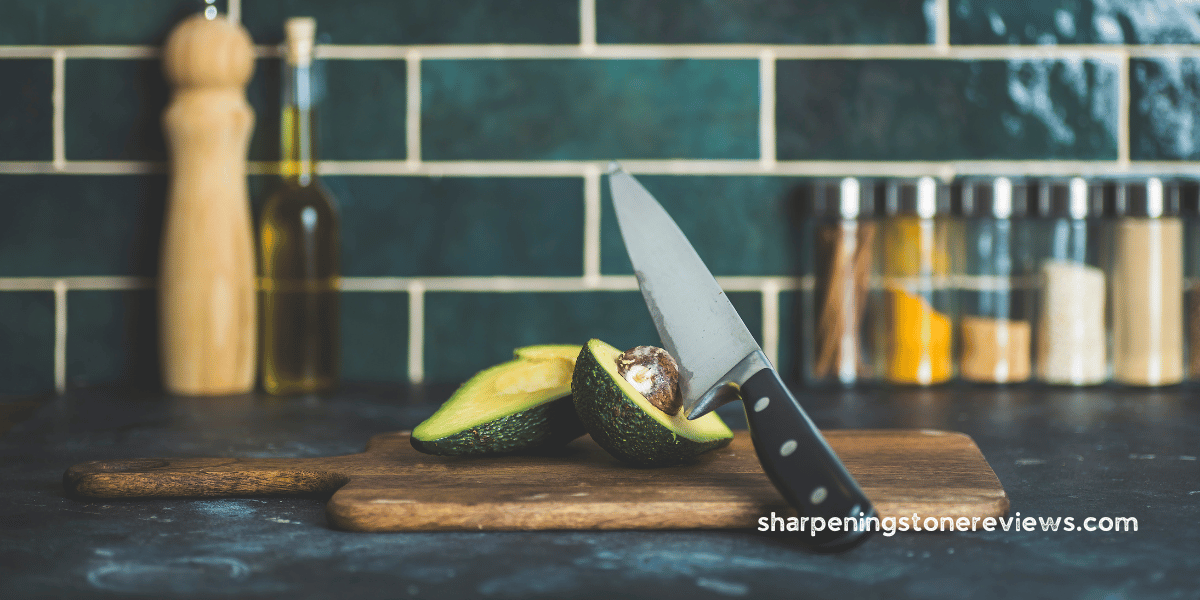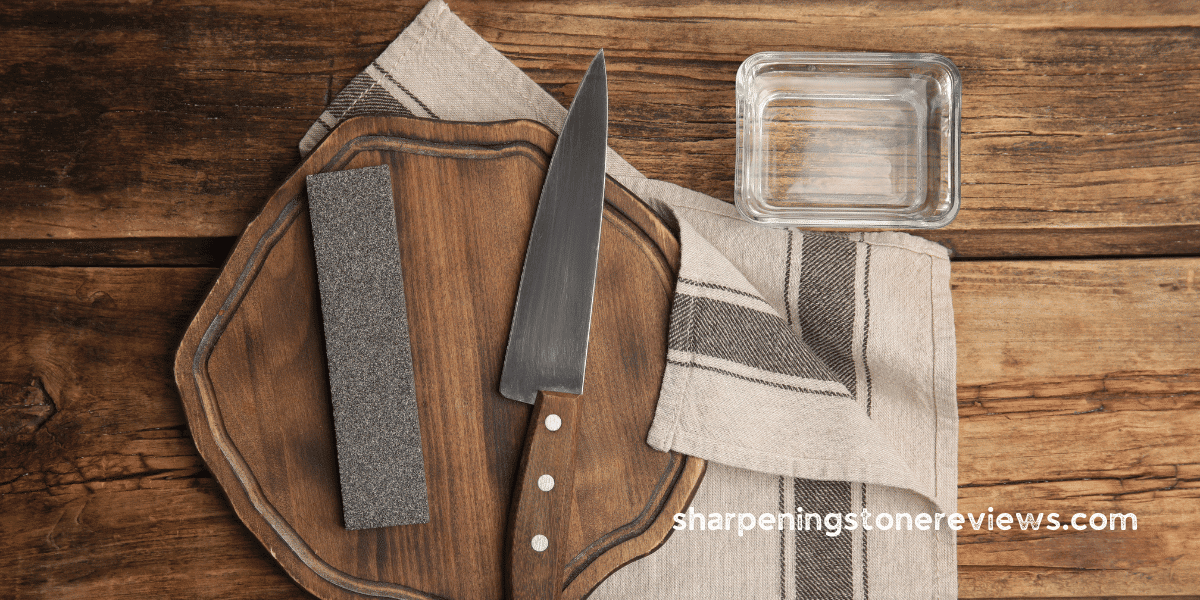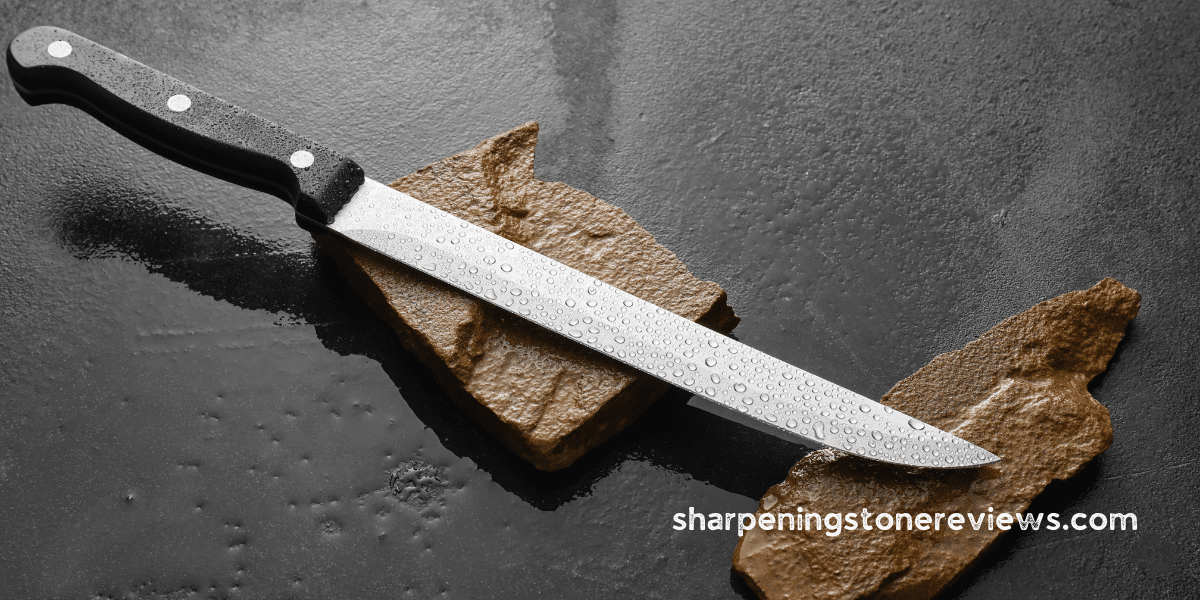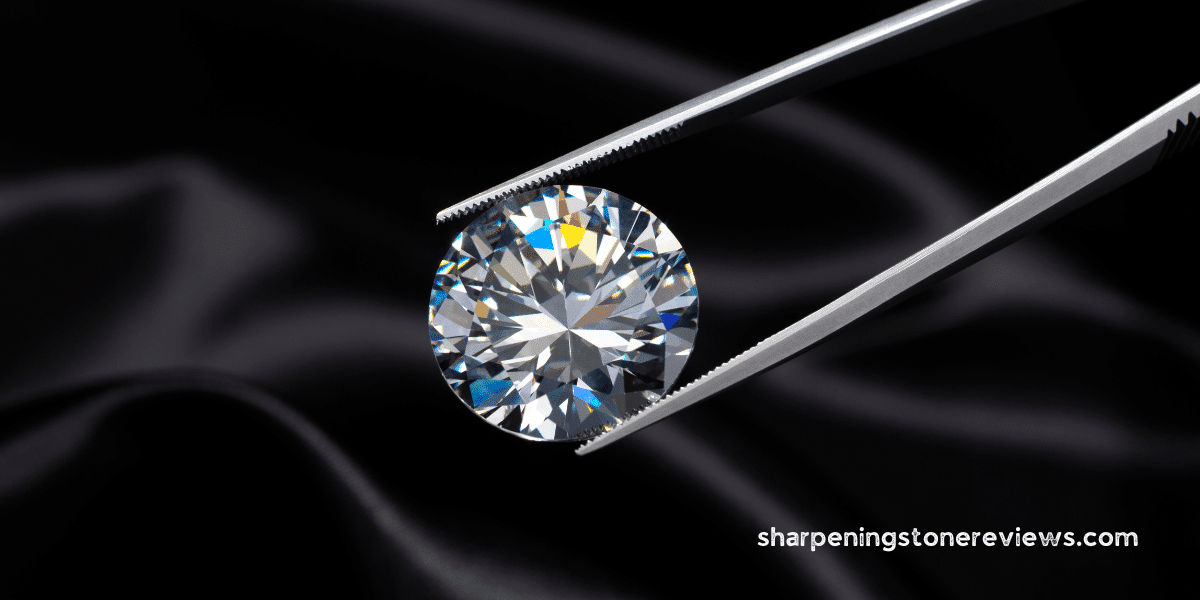Do you want to feel confident and secure in your kitchen? Then, a sharp knife is your best ally.
Picture this: You’re preparing a delicious meal, effortlessly slicing through ingredients with precision and control. No slips, no accidents.
A dull knife? It’s like trying to cut through a tough obstacle blindly, risking injury at every turn. But with a sharp knife, you have the power to conquer any culinary challenge safely and efficiently.
In this article, we’ll explore why a sharp knife is not just a tool but also your key to kitchen safety.
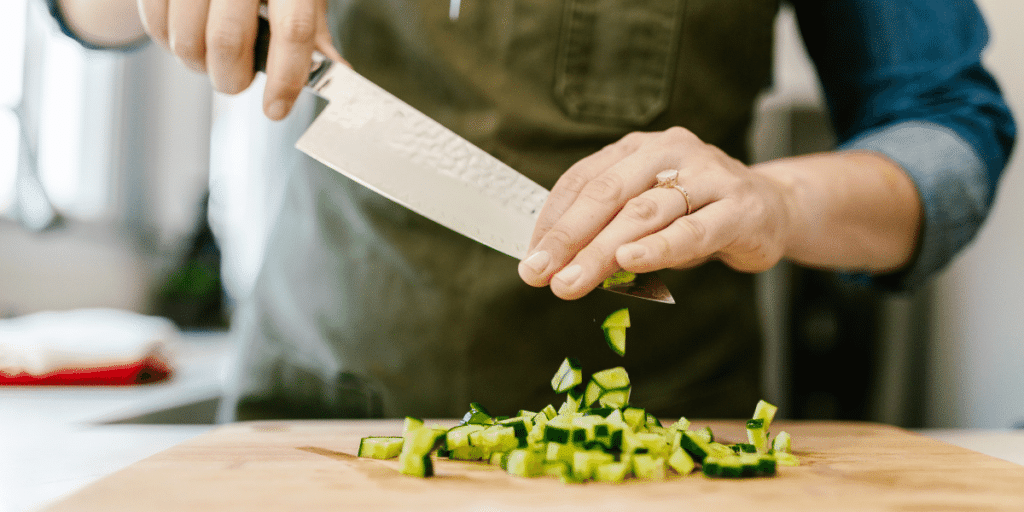
Precision cutting
When you have a sharp knife, you are able to make precise cuts with ease. Unlike dull knives, which require more pressure and effort to cut through objects, sharp knives give you better control over the tool. With a sharp knife, you can confidently slice through ingredients without worrying about the blade slipping and potentially cutting yourself. The precision that comes with using a sharp knife ensures that your cuts are clean and accurate.
One way to test if your knife is sufficiently sharp is by using the tomato rule. Simply try slicing through a tomato without squashing it. If your knife effortlessly glides through the fruit, then it is sharp enough for safe cutting. Regularly checking the sharpness of your knife and sharpening it when necessary is crucial for maintaining its functionality as a safe tool.
By keeping your knives sharp, you reduce the risk of accidents and injuries in kitchen. Dull knives not only require more force to cut through food but also increase the chances of slips and cuts due to their lack of control. A dull pocketknife used for self-defense can be ineffective and even harm you in an emergency situation.
Reduced slip accidents
Using a well-honed blade decreases the likelihood of accidents caused by slipping. When your knife is sharp, it provides better control and stability, reducing the risk of slip accidents. A dull knife requires more force to cut through objects, increasing the chances of losing control and potentially harming yourself. By keeping your knives sharp, you ensure that they perform efficiently and safely.
Sharp kitchen knives are essential for maintaining safety in the kitchen. Dull knives can easily slip off food surfaces and cause injuries. With a sharp knife, you can confidently execute proper knife techniques without putting your safety at risk. Whether you’re slicing vegetables or deboning meat, a sharp knife allows for precise movements, minimizing the chance of accidents.
Knife accidents often occur due to improper handling or technique. However, using a sharp knife enhances your ability to employ correct cutting methods. The sharper the blade, the easier it is to maintain proper grip and control over the knife. This reduces the likelihood of slips and mishaps during food preparation.
Remember that safety should always be a priority when working with knives. Regularly sharpening your kitchen knives not only ensures their effectiveness but also minimizes potential risks associated with using dull blades. By prioritizing proper maintenance and honing techniques, you can enjoy safer cooking experiences while achieving optimal results in your culinary endeavors.
So keep those blades sharp and stay safe in the kitchen!
Efficient food prep
To increase your efficiency in food prep, ensure that your tools are properly maintained and ready for use. One of the most important tools in the kitchen is a knife. A sharp knife is not only essential for cutting food effectively, but it also contributes to your safety. Here’s why a sharp knife is a safe knife:
- Precision: A sharp knife allows you to have better control over your cuts, resulting in more precise and uniform slices. This reduces the risk of unevenly cut pieces that can lead to cooking inconsistencies.
- Reduced Risk of Injury: Contrary to what one might think, using a sharp knife actually decreases the chance of accidents. A dull blade requires force to cut through food, which can cause it to slip and potentially harm your fingers.
- Efficient Cutting: With a sharp knife, you can effortlessly glide through different ingredients without exerting excessive pressure or sawing motions. This not only saves time during meal preparation but also minimizes strain on your hands and wrists.
- Minimized Food Contamination: When working with dull knives, there’s an increased likelihood of crushing or tearing rather than cleanly slicing through food items like fruits and vegetables. This can result in bacterial contamination as well as affect the overall presentation of dishes.
Regularly sharpening your kitchen knives ensures that they remain effective tools for food preparation while reducing risk of accidents or injuries associated with dull blades. Remember, a sharp knife is not just about convenience; it’s about maintaining a safe environment in your kitchen while enjoying efficient and enjoyable cooking experiences.
Clean, controlled cuts
Ensure your cuts are clean and controlled by maintaining a sharp edge on your kitchen tool. A sharp knife is essential for achieving precise, safe, and efficient cutting techniques. When the blade of your knife is sharp, it effortlessly glides through ingredients, resulting in clean cuts with minimal effort. This not only enhances the aesthetics of your food but also reduces the risk of accidents and injuries.
A safe knife begins with a well-maintained edge. Regularly sharpening and honing your knife ensures that its blade remains sharp and ready for use. A dull or blunt knife requires more force to cut through materials, increasing the chances of slips or mishaps that can lead to cuts. On the other hand, a properly sharpened knife allows you to maintain control over your cutting motions, allowing for precise and controlled cuts.
In addition to regular sharpening, proper care of your knife’s edge is crucial for maintaining its safety. Always store knives in protective sheaths or blocks to prevent accidental contact with the blade. Avoid using hard surfaces such as ceramic plates or glass cutting boards that can damage the knife’s edge. Instead, opt for softer surfaces like wooden or plastic cutting boards.
Remember to practice good knife safety basics as well. Hold the handle firmly with a steady grip while keeping your fingers away from path of the blade. Use proper cutting techniques, such as curling your fingers under when chopping or slicing, to avoid potential accidents.
Minimizes hand fatigue
Regularly sharpening your kitchen tool helps you minimize hand fatigue, allowing for more comfortable and efficient cutting. A sharp knife is safe knife because it minimizes hand fatigue, reducing the strain on your muscles and joints. When using a dull knife, you need to apply extra force to make cuts, which can quickly tire out your hands and lead to discomfort or even injury. However, with a sharp knife, the blade effortlessly glides through ingredients with minimal effort from you.
A sharp knife’s ability to cut smoothly and efficiently reduces the need for repetitive motions and excessive pressure. This significantly decreases the strain on your hands and wrists while also minimizing the risk of slipping or losing control of the blade. By minimizing hand fatigue, a sharp knife allows you to maintain better control over your cutting actions.
Furthermore, when your hands are less fatigued, you can work more comfortably and confidently in the kitchen or any other setting where a sharp knife is essential. The reduced effort required when using a sharp knife not only improves safety but also enhances productivity by allowing you to work faster without compromising accuracy.
To ensure that your knife remains sharp and safe to use, it is important to regularly hone and sharpen it. Honing realigns the edge of the blade while sharpening removes any nicks or imperfections that may have developed over time. By incorporating these tasks into your regular maintenance routine, you can continue enjoying the benefits of a safe and efficient cutting tool while minimizing hand fatigue during food preparation or other activities that involve using a sharp knife.
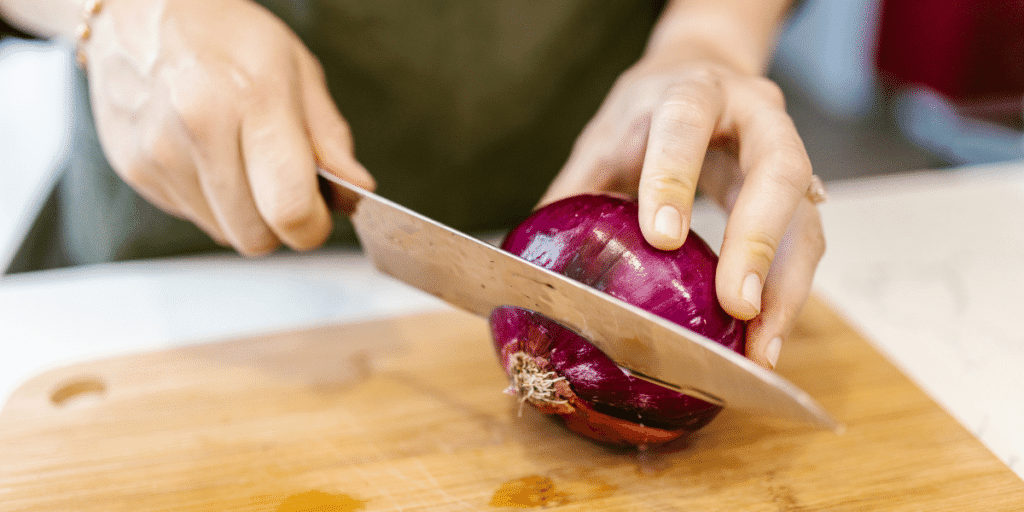
Less force required
In the previous subtopic, we discussed how a sharp knife minimizes hand fatigue. Now, let’s explore another reason why a sharp knife is a safe knife: less force is required.
Efficiency: When you use a sharp knife, it effortlessly cuts through various objects with minimal effort. The keen edge allows the blade to glide smoothly and efficiently through ingredients or materials.
Reduced Risk of Injury: A dull knife requires more force to cut, increasing the risk of injury. With a blunt knife, there is a higher chance of slipping and losing control during cutting motions. In contrast, a sharp knife gives you better control over the blade and reduces the likelihood of accidents.
Safe Cutting Techniques: Sharp knives promote safe cutting techniques as they allow for precise and controlled movements. You can easily make clean cuts by using proper slicing or chopping techniques without exerting excessive pressure on the blade.
A sharp tool provides numerous advantages when it comes to safety while handling knives. By requiring less force during usage, it enhances your control over the blade and minimizes the risk of injury caused by accidents or lack of control.
Remember that maintaining knife sharpness is crucial for its intended purpose and should be regularly checked and sharpened as needed. Using properly sharpened knives not only ensures safer cooking practices but also increases efficiency in any cutting task at hand.
Safer food handling
When handling food, make sure to practice proper hygiene and cleanliness. One important aspect of safe food handling is using a sharp knife. A sharp knife not only makes cutting and slicing easier but also contributes to safer food preparation.
Using a sharp knife ensures that you have better control over the blade, reducing the risk of accidents. With a dull knife, more force is required to cut through ingredients, increasing the chances of slipping and cutting yourself. A sharp knife allows for precise cuts, minimizing the likelihood of injuries.
In addition, a sharp knife helps to maintain the integrity of your ingredients. When using a dull knife, there is higher chance of crushing or bruising delicate foods like tomatoes or herbs. This can result in uneven cooking and compromised flavors. By using a sharp knife, you can ensure that your ingredients are handled with care and remain intact.
Another benefit of using a sharp knife is that it reduces the likelihood of cross-contamination. A dull knife tends to tear through food rather than cleanly slice it. This tearing action can spread bacteria from one ingredient to another if not properly cleaned between uses. With a sharper blade, you can make clean cuts without dragging any residue from previous slices.
To ensure safer food handling with your knives, remember these key tips:
- Regularly sharpen your kitchen tools.
- Use appropriate cutting surfaces such as wooden or plastic boards.
- Clean knives thoroughly after each use to remove any food residue.
- Store your knives properly in designated slots or sheaths.
Practicing good knife safety tips and maintaining sharp blades will contribute to safer food handling in your kitchen. So keep those knives sharpened for efficient and secure meal preparation!
Accurate slicing technique
To achieve precise and consistent slices, make sure you maintain a steady grip on the handle while applying even pressure with your index finger. This accurate slicing technique is crucial for safe knife usage. A sharp knife is safe knife because it allows for proper control and reduces the risk of accidents. When using a dull blade, you need to exert more force, which can lead to slipping and cutting yourself. To emphasize the importance of using a sharp knife, consider the following table:
| Dull Blade | Sharp Knife |
|---|---|
| Increases chances of accidents | Reduces risk of accidents |
| Requires more pressure to cut | Requires less force to cut |
| Difficult to maintain control | Provides better control |
Maintaining a proper cutting angle is also essential for accurate slicing. Hold the knife at approximately 15-20 degrees from the cutting surface to ensure efficient cutting and minimize resistance. Additionally, regularly checking the sharpness of your knife with a simple test can help prevent accidents. Run your fingernail gently across the blade’s edge – if it catches or feels rough, it’s time to sharpen it.
Investing in good quality knife sharpener is highly recommended for maintaining blade sharpness. Regularly sharpening your knives not only ensures their safety but also guarantees their functionality when needed. Remember that a sharp knife allows for precise actions, reducing the chances of injuries during use.
Decreased risk of injury
Regularly sharpening your blades decreases the likelihood of getting injured. Here’s why a sharp knife is a safe knife:
- A sharp knife provides better control and precision, reducing the risk of slips and accidental injuries. A dull knife can easily slip on food surfaces, increasing the chances of lacerations.
- Using a sharp knife requires less force, minimizing the strain on your hand and reducing the risk of repetitive motion injuries.
- When a knife is blunt, you may exert more pressure while cutting, causing food to move unexpectedly or even roll off the cutting board. A sharp knife ensures clean cuts and minimizes this risk.
- Properly maintained knives are less likely to need sudden repairs or replacements due to damage caused by improper use. Regular sharpening extends their lifespan.
To keep your knives safe and in good condition:
- Store them properly: Use a dedicated knife block or magnetic strip to store knives safely. Avoid throwing them into drawers where they can become damaged or cause accidents when reaching for other items.
- Follow proper knife etiquette: Always cut away from your body and keep your fingers clear of the blade path to prevent accidental cuts.
- Keep your workspace organized: Cluttered countertops can make knives slippery and increase the chance of accidents. Maintain adequate space for cutting and avoid overcrowding with other utensils or ingredients.
- Learn proper technique: Educate yourself on correct cutting techniques that maximize safety and efficiency, such as using a claw grip when chopping ingredients.
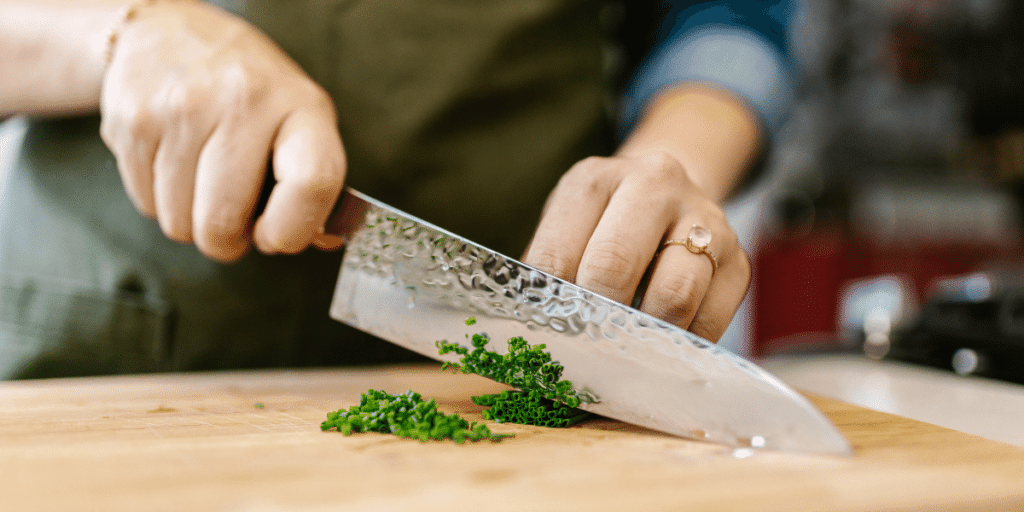
Enhanced kitchen safety
Now that you understand importance of using a sharp knife and how it decreases the risk of injury, let’s delve into how a sharp knife enhances kitchen safety.
Using sharper knives in the kitchen is one of the most crucial knife safety tips. A dull knife edge requires more force to cut through objects, increasing the chances of slips and accidents. On the other hand, a sharp knife allows for clean and precise cuts, reducing risk of injuries.
To ensure enhanced kitchen safety, proper knife training is essential. Knowing how to handle a sharp knife correctly and following the rule about knives can prevent accidents. It’s important to establish a safe knife routine by always using a sharp knife and practicing good cutting techniques.
By using a sharp knife in your kitchen, you enhance overall kitchen safety. A sharp blade allows you to exert less pressure when cutting ingredients, minimizing the likelihood of slips or unexpected movements that could result in injuries. Additionally, with a sharper edge on your knife, there is less chance of food sticking to blade while cutting, further reducing accidents caused by slipping or loss of control.
Remember, maintaining a consistently sharp knife ensures enhanced kitchen safety. Regularly check your knives’ sharpness and sharpen them as needed to guarantee their functionality when needed. By incorporating these practices into your culinary routine, you’ll be promoting safer conditions in your kitchen and reducing potential hazards associated with dull blades.
In conclusion, maintaining a sharp knife is crucial for your safety and effectiveness in various scenarios.
A sharp knife allows for precise and controlled cuts, reducing the risk of slip accidents and injuries. It enhances kitchen safety by minimizing hand fatigue and ensuring accurate slicing techniques.
Like a trusted ally by your side, a sharp knife becomes an extension of your skillful hands, making food preparation efficient and safe.
So remember, regularly sharpening your knife is like giving it a well-deserved spa treatment, ensuring its optimal performance and keeping you protected from harm.
Frequently Asked Questions
How Often Should I Sharpen My Knife?
You should sharpen your knife regularly to ensure its effectiveness. Honing it after every five uses and sharpening it at least twice a year is recommended. Use the tomato test or create your own rule based on your needs and usage.
What Are Dangers of Using a Dull Knife in the Kitchen?
Using a dull knife in kitchen is risky. It requires more force, increases the chance of slipping, and leads to accidents. A sharp knife is safer, allowing for precise actions and reducing the risk of injury.
Can a Dull Knife Be Effective for Self-Defense?
A dull knife is ineffective for self-defense. It requires more force to cut and increases the risk of injury. A sharp knife, on the other hand, allows for precise actions and reduces the likelihood of harm.
How Can I Determine if My Knife Is Sharp?
To determine if your knife is sharp, use the “tomato test”: if it slices through without squashing, it’s sharp. Regularly check and sharpen your knife to prevent injuries and ensure its effectiveness in self-defense situations.
Why Is It Important to Regularly Sharpen My Knife?
Regularly sharpening your knife is vital for its effectiveness. It prevents dullness, reducing the risk of self-injury. A sharp knife is crucial for self-defense situations and ensures proper functionality when needed.
